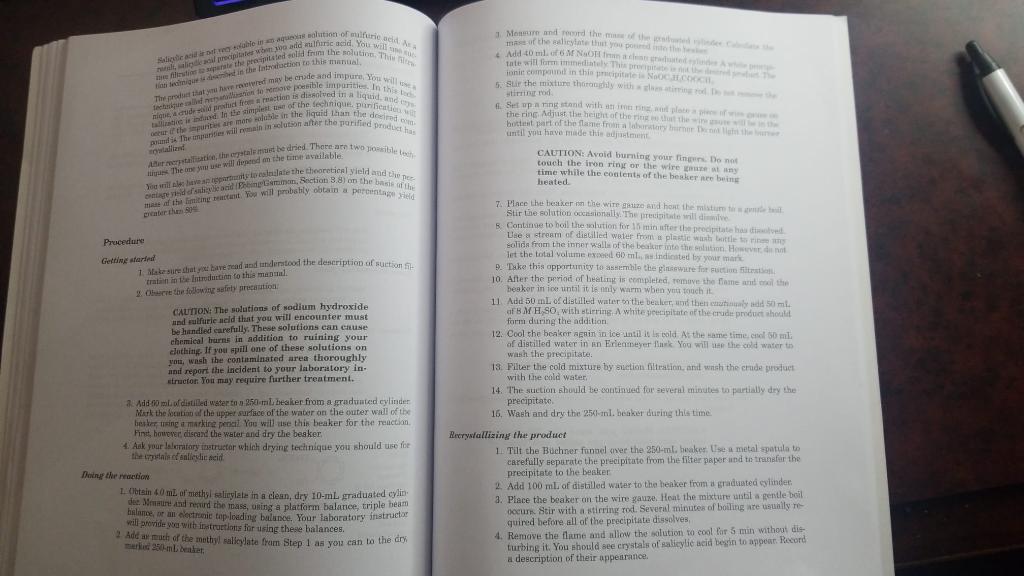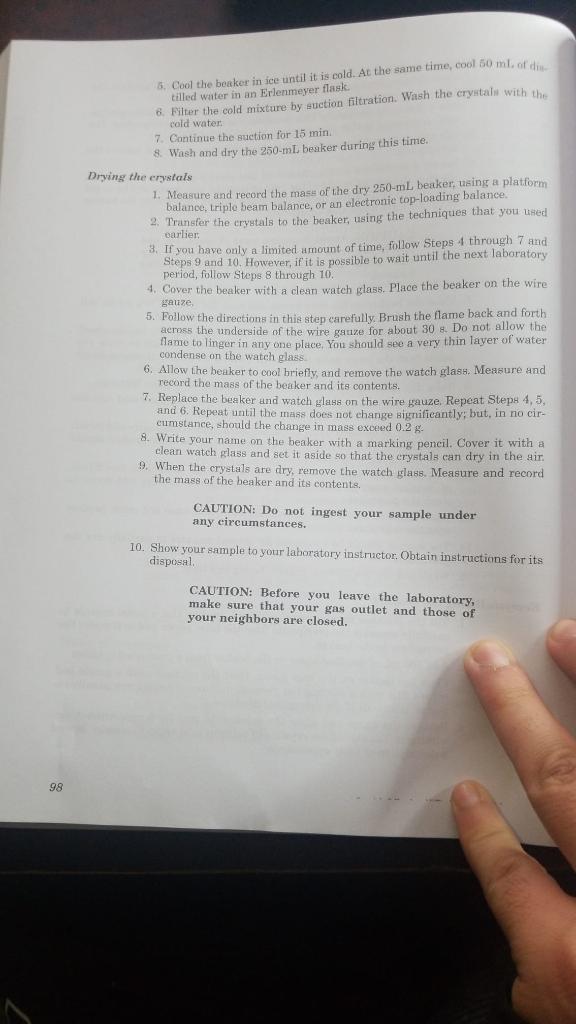a. Draw sketches of methyl salicylate and salicylic acid, showing every bond. .
b. What is the limiting reactant in this experiment? Why? The density of methyl salicylate is 1.18 g/mL at 20C.
c. What safety precautions must be observed during this experiment? 


10. From Oil of Wintergreen to Salicylic Acid Introduction what happens during a chemical reaction? Reactant molecules are commented to product molecules es chemical bands are formed a broken. Recens the properties of a molecule dered in part on the basis within the molecule, the properties of the reactant differ from those of the product. These difference are often Inge This experiment deals with a chemical reacties in which there is a significant and easily noticed difference between the properties of a reactant and those of a prodaet: The reactant is a liquid and the product is a solid. Some of the substances in this experiment are called organic compounds Organic chemiatry deals with compounds in which carbon is the principal element Purpose You will examine the chemical reaction in which methyl salicylate coil of win- tergreen), a liquid, is converted to salicylic acid, a solid. The actual yield of this product will be compared with the theoretical yield. Some interesting facts Methyl salicylate, well known for its characteristie wintergreen odor, i ed as a flavoring and as an ingredient in various liniments. Salicylic acid, which is used in the preparation of aspirin shares aspirin's ability to relieve pain. Concept of the experiment When methyl salicylate (HOCH COOCH) is heated in water, salicylic acid CHOCH.COOH) and methyl alcohol (CH OH are formed slowly. This reaction is shown in Figure 1.1. You can obtain a faster reaction if you replace the water with an aqueous solution of sodium hydroxide. When the reaction is complete, the sodium hydroxide can be removed chemically by the addition of sulfuric acid. Although the conversion of methyl salicylate to salicylic acid becomes slightly more complicated under these conditions, the overall results are virtually identical to those shown in Figure 1.1. Ooh , + 1,0 COOH + CH,OH PURE 11 The reaction of methyl salicylate toil of wintergreen with water to give salicylic acid and methyl hal Methyl alcohol Metylsalicylate Salicylic acid 95 hat die weddwl acid You w Salong the question of mature te the pred solid frun the solution. The Han vaig in the action to thital night crudes fractions dissolved in and Techniques to more posible impurities. In the Our f the unit mane olable in the liquid than the deed Das eindd In the simple of the technique Men and the more me of the valleylate that you Add 40 ml. Men tate will form med This one compound in this recipe NOCH 5 sur the mixture they with the 6. Set up a ring stand with the ring Adjust the height of the in the hottest part of the fame from the until you have made this adjustment CAUTION: Avoid burning your fingers. Do not touch the iron ring or the wire many time while the contents of the beaker are being Die wil in solution after the Tarified product has Arrathastale must be dried. There are two posible Barcollate the theoretical yield and the DAR of acid EPGAAG, Section 3.8) on the bath med them to You will probably obtain a perche The will depend on the time available beated Sier Procedure Getting started 1. Melzeure that you have read and understood the description of suctions 2. Or the following safety precaution CAUTION: The solutions of sodium hydroxide und wulfurie seld that you will encounter must be handled carefully. These solutions can cause chemical burns in addition to ruining your clothing. If you spill one of these solutions on you, wash the contaminated area thoroughly and report the incident to your laboratory in structor. You may require further treatment. 7. Place the beaker on the wine suze and host the misture Stir the solution ocasionally. The will die Continge to holl the solution for 15 min after the precipitati Use a stream of distilled water from a plastic wash bottles solide from the inner walls of the beaker to the Howevent let the total volume exceed 60 ml indiested by your man D. Dike this opportunity to assemble the glassware for suits 10. After the period of beating is completed, remove the time and the beaker inice until it is only warm when you touch it 11 Add some of distilled water on the beauer, then add 50 ml of BMH SO with stirring A white grecipitate of the crude product should form during the addition 12. Cool the beaker gin in ice until it is cold. At the same time col 50 ml of distilled water in an Erlenmeyer finsk You will be the cold water is wash the precipitate 13. Filter the cold mixture by action filtration, and wnsh the chide product with the cold water 14. The suction should be continued for several minutes to partially dry the precipitate 16. Wash and dry the 25-nl. beaker during this time Recrystallizing the product 1. Tilt the Bchner funnel arver the 200 ml baker. Use a metal spatula to carefully separate the precipitato from the filter paper and to transfer the precipitate to the besker 2. Add 100 ml of distilled water to the heaker from a graduated cylinder a. Place the beaker on the wire gauze. Heat the mixture until a gentle boil Our Stir with a stirring rod. Several minutes of boiling are usually quired before all of the precipitate dissolves 4. Remove the flame and allow the solution to cool for 5 min without die turbing it. You should see crystals of salicylic acid begin to appear. Record a description of their appearance Add 60 ml of distilled water to a 250 ml beaker from a graduated cylinder Mark the location of the upper surface of the water on the outer wall of the beskerming & marine pencil You will use this beaker for the reaction Fint, however, discard the water and dry the beaker, 4. Auk your laleatory retructor which drying technique you should use toe Ils of enesli neid Doing the ration L. Obtain 40 mL of methyl salicylate in a clean, dry 10-ml graduated cylin det. Men and record the mass, uning a platform balance, triple heam balance, or electronic top-loading balance. Your laboratory instructor will provide you with instructions for using these balances. 2 Add ar much of the methyl salicylate from Step 1 as you can to the dry Cool the beaker in ice until it is cold. At the same time, cool 50 mlodi tilled water in an Erlenmeyer flask 6. Filter the cold mixture by suction filtration. Wash the crystals with the cold water 7. Continue the suction for 15 min 8. Wash and dry the 250-ml beaker during this time, Drying the crystals 1. Measure and record the mase of the dry 250-ml beaker, using a platform balance, triple beam balance, or an electronie top-loading balance 2. Transfer the crystals to the beaker, using the techniques that you liked earlier 3. If you have only a limited amount of time, follow Steps 4 through 7 and Steps 9 and 10. However, if it is possible to wait until the next laboratory period, follow Steps 8 through 10. 4. Cover the beaker with a clean watch glass. Place the beaker on the wire gauze, 5. Follow the directions in this step carefully. Brush the flame back and forth across the underside of the wire gange for about 30 s. Do not allow the Name to linger in any one place. You should see a very thin layer of water condense on the watch glass 6. Allow the beaker to cool briefly, and remove the watch glass. Measure and record the mass of the beaker and its contents. 7. Replace the beaker and watch glass on the wire gauze. Repeat Steps 4,5 and 6. Repeat until the mass does not change significantly; but, in no cir cumstance, should the change in mass exceed 0.2 g 8. Write your name on the beaker with a marking pencil. Cover it with a clean watch glass and set it aside so that the crystals can dry in the air 9. When the crystals are dry, remove the watch glass. Measure and record the mass of the beaker and its contents. CAUTION: Do not ingest your sample under any eircumstances. 10. Show your sample to your laboratory instructor. Obtain instructions for its disposal CAUTION: Before you leave the laboratory, make sure that your gas outlet and those of your neighbors are closed. 98









